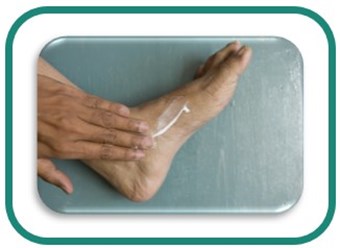Looking after your foot in remission

You are in the in remission category as you have had a previous ulcer, amputation or Charcot foot. Being in this category means that there is a very high risk that you will develop further foot ulcers or have a further amputation. You may also have a new incidence of Charcot foot.
Your podiatrist will tick which of the following you are in remission from:
- You have had an ulcer or ulcers before
- You have had an amputation
- You have Charcot foot
The development of foot wounds in people with diabetes is serious as they are linked to an increased risk of heart attacks, strokes, amputations of the foot or leg and early death.
Controlling your diabetes, cholesterol and blood pressure, stopping smoking, increasing cardiovascular exercise and controlling your weight helps to reduce the risk of these life-and limb-threatening problems.
As your feet are in the in remission category you will need to take extra care of them. You will have a treatment/management plan introduced by a podiatrist experienced in the diabetic foot and agreed with yourself.
If you follow the advice and information here, it will help you to take care of your feet between visits to your podiatrist. This will help you to reduce the risk of developing life-and limb-threatening problems.
If you develop any of the following problems, it is important that you contact your Multi-disciplinary Foot Care Team, local Podiatry Department or GP for advice as soon as possible (within 24 hours).
- A red, hot, swollen toe or foot
- A new break or wound in the skin
- New redness or discolouration of your toe or foot
- New or unexplained pain in your foot
If your Multi-disciplinary Foot Care Team, GP or Podiatry Department are not available, and there is no sign of your foot healing within 24 hours, go to your local accident and emergency department.
What can I do to reduce my risk of developing problems?
Check your feet every day
You should check your feet every day for any blisters, breaks in the skin, pain or any signs of infection such as swelling, heat or redness.
If you discover any breaks in the skin or blisters, cover them with a sterile dressing. Do not burst blisters.
If you cannot do this yourself, ask your partner or carer to help you.
Badly-fitting footwear
Badly-fitting shoes are a common cause of irritation or damage to feet. The podiatrist who assessed your feet may give you advice about the shoes you are wearing and advise you on buying new shoes.
Depending on your need, you may be assessed for prescription footwear, insoles
or both.
Skin care for your feet
You should wash your feet every day in warm water and with a mild soap. Rinse them thoroughly and dry them carefully, especially between the toes.
Do not soak your feet as this can damage your skin. Because of your diabetes, you may not be able to feel hot and cold very well. You should test the temperature of the water with your elbow, or ask someone else to test the temperature for you. If your skin is dry, apply a moisturising cream, avoiding the areas between your toes.
Toenail care
Do not cut your toenails unless your podiatrist advises you to do so.
Socks, stockings or tights
Change your socks, stockings or tights regularly. They should not have bulky seams and the tops should not be elasticated.
Avoid walking barefoot
If you walk barefoot you risk injuring your feet by stubbing your toes and standing on sharp objects which can damage the skin.
Check your shoes
Check the bottom of your shoes before putting them on to make sure that nothing sharp such as a pin, nail or glass has pierced the outer sole. Also, run your hand inside each shoe to check that no small objects such as small stones have fallen in.
Prescription shoes
If you have been supplied with shoes, they will have been made to a prescription. You should follow the instructions your podiatrist or orthotist (the person who prescribed or designed your shoes) gives you. These should be the only shoes you wear. Shoes will normally be prescribed with insoles. These are an important part of your shoes and you should only remove them if your orthotist or podiatrist advises you to. Whoever provided your shoes will advise you about any repairs or alterations to make sure that they will match your prescription. Prescription footwear and insoles can reduce the risk of ulcers but cannot remove the risk altogether.
Hard skin and corns
Do not try to remove hard skin or corns yourself. Your podiatrist will provide treatment and advice where necessary.
Over-the-counter corn remedies
Do not use over-the-counter corn remedies. They are not recommended for anyone with diabetes as they can be highly dangerous and can lead to new wounds and infections.
Avoid high or low temperatures
If your feet are cold, wear socks. Never sit with your feet in front of the fire to warm them up. Always remove hot-water bottles or heating pads from your bed before getting in.
Appointments
It is important that you attend all of your appointments with the Foot Protection Team or specialist podiatrist, as well as your other regular diabetes review appointments. This will reduce the risk of problems developing.
What should I do if I have a concern or problem with my feet?
If you have any concerns or discover any problems with your feet, contact your Multi-disciplinary Foot Care Team, local Podiatry Department, Foot Protection Team or GP for advice immediately.
If they are not available, go to your nearest accident and emergency department. Remember, any delay in getting advice or treatment when you have a problem can lead to serious problems
Resources:
Looking after your foot in remission to reduce the risk of further ulcers and amputation pdf